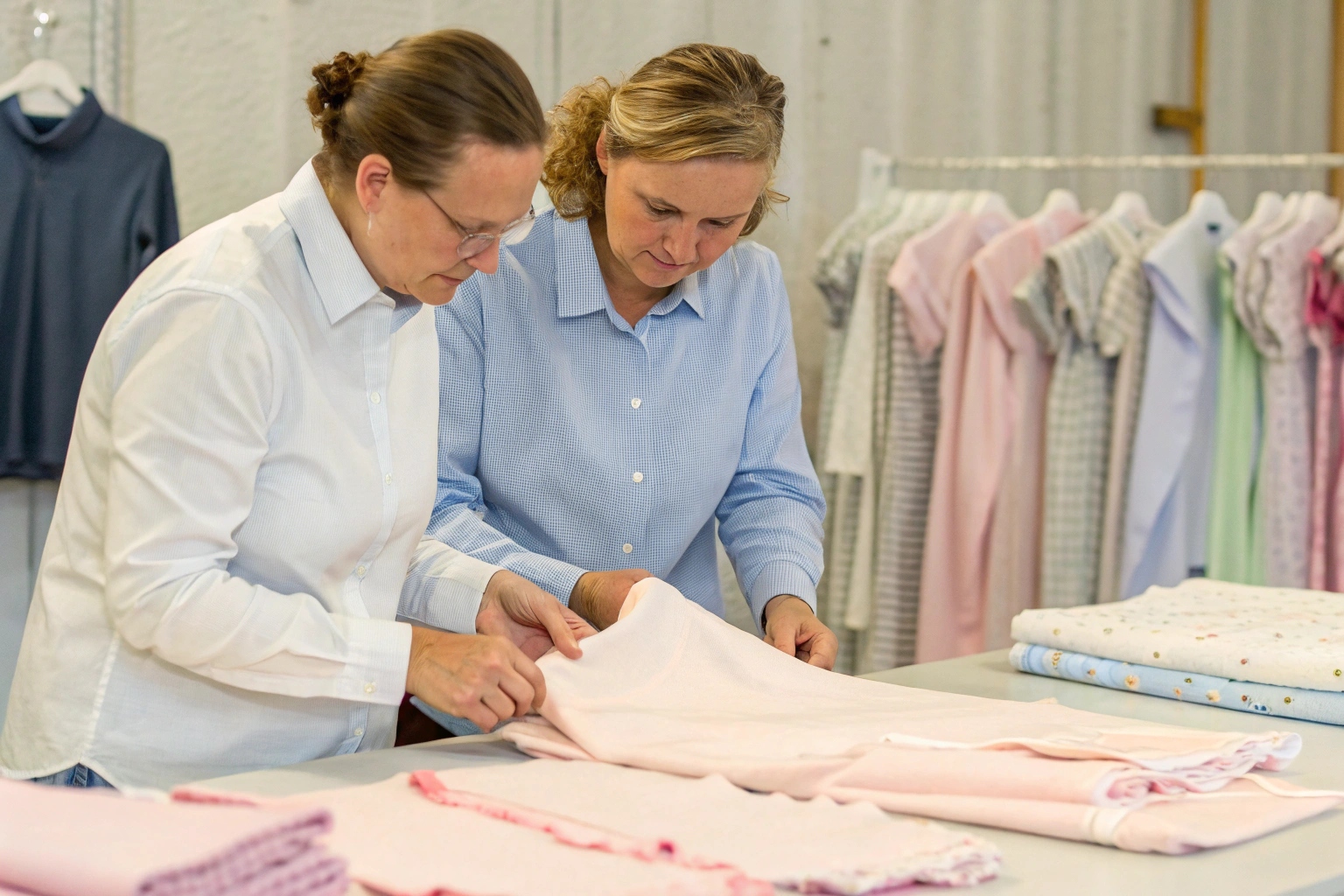Babies have delicate, sensitive skin—so even the softest-looking clothing can cause discomfort or allergic reactions if it’s not made thoughtfully.
To make your babywear line skin-friendly, use certified soft fabrics, avoid harsh chemicals, and clearly test and label each product for safety.
This guide explains how to create truly skin-safe babywear—trusted by parents and loved by babies.
What Fabrics Are Best for Sensitive Baby Skin?
The fabric touches a baby’s skin all day—so it needs to be breathable, soft, and free from irritants.
The best fabrics for babywear are organic cotton, bamboo, and OEKO-TEX® certified textiles that are soft, breathable, and chemical-free.

Which fabrics are ideal for babywear?
| Fabric Type | Benefits for Baby Skin |
|---|---|
| Organic cotton | Hypoallergenic, pesticide-free, ultra soft |
| OEKO-TEX® cotton | Tested for harmful chemicals |
| Bamboo viscose | Naturally soft, moisture-wicking |
| Modal | Gentle, smooth, breathable |
| Muslin | Light, breathable, great for warm weather |
Avoid:
- Polyester-heavy blends that trap heat
- Synthetic finishes or water-repellent coatings
- Harsh dye treatments that leave residue
We recommend 100% cotton or bamboo blends for direct skin contact items like onesies, rompers, and sleepwear.
How to Avoid Allergens and Irritants in Babywear?
Even high-quality fabric can become unsafe if harsh chemicals, stiff seams, or rough prints are added during manufacturing.
To avoid allergens and irritants in babywear, use low-impact dyes, soft thread, smooth seams, and avoid chemical softeners or harsh printed decorations.

What are the most common irritants in baby clothes?
| Potential Irritant | Risk |
|---|---|
| Formaldehyde | Used in wrinkle-resistant finishes |
| Heavy metals in dyes | May cause rashes or allergic reactions |
| Fragrance additives | Found in "scented" fabrics |
| Rough seams or tags | Cause redness or pressure marks |
| PVC-based screen prints | Can peel and irritate sensitive skin |
Instead of harsh softeners, we use enzyme-washed or naturally combed cotton to ensure softness.
How can brands reduce skin reaction risks?
- Work only with OEKO-TEX® or GOTS-certified mills
- Choose tagless or printed neck labels
- Use soft, high-stretch seams (flatlock or coverstitch)
- Avoid glitters, foils, or plastisol inks
- Test shrinkage and dye bleed before approval
At Fumao, we review every trim, fabric, and print process for skin contact safety—especially for infantwear collections.
Why OEKO-TEX and GOTS Certifications Matter?
Safety isn’t a guess—it’s something you prove. Certifications provide assurance to both parents and retailers that your garments are truly skin-safe.
OEKO-TEX® and GOTS certifications confirm your babywear is free of harmful substances, sustainably processed, and safe for newborn skin.

What do OEKO-TEX and GOTS certify?
| Certification | What It Covers |
|---|---|
| OEKO-TEX® Standard 100 | Tests for 100+ harmful chemicals in fabrics and accessories |
| GOTS (Global Organic Textile Standard) | Ensures organic fiber + sustainable processing |
| CPSIA (U.S. compliance) | Ensures tracking labels, lead-free snaps, flammability safety |
OEKO-TEX® is the most widely used chemical safety test in babywear, and applies to everything from fabric to thread to buttons.
GOTS goes further, covering not only organic fiber content but also ethical labor and environmentally responsible processing.
How do brands get certified?
- Source fabric from certified mills
- Work with suppliers who offer transaction certificates
- Ensure labels, snaps, dyes, and packaging also meet certification standards
- Provide test results and batch IDs in your compliance folder
At Fumao, we offer both OEKO-TEX® certified cotton and GOTS-certified organic cotton depending on the brand’s needs and market.
Tips for Testing and Labeling Skin-Safe Baby Clothes?
Testing and labeling may seem technical—but they’re critical for building trust, reducing returns, and staying compliant.
Test babywear using lab-approved methods, label it with accurate fiber content and care instructions, and include clear safety or certification markings.

What testing is recommended for skin-friendly babywear?
| Test Type | What It Ensures |
|---|---|
| Colorfastness (saliva, sweat) | Dyes won’t irritate or transfer |
| Fabric pH test | Ensures fabric matches skin pH |
| Nickel-free snap test | Prevents allergic reactions |
| Softness comparison | Fabric feel over time after washing |
We run in-house testing or send to certified labs (SGS, Intertek, TÜV) depending on order size and target market.
What should go on your labels?
- Fiber content (e.g., 100% organic cotton)
- Size and care instructions
- OEKO-TEX® / GOTS / CPSIA logos if applicable
- Tracking label (required in U.S. under CPSIA)
- Optional: “Skin-safe,” “Certified non-toxic,” or “Hypoallergenic” based on tests
Using printed neck labels or soft woven ones helps reduce friction on the baby’s skin.
Conclusion
Skin-friendly babywear starts with fabric—but it ends with attention to every detail. When you use safe materials, test thoroughly, and label honestly, you earn the trust of parents—and give babies the comfort they deserve.










